If you have been suspected or diagnosed with gout which is a type of arthritis, and now you are looking for ways to get rid of this bone deforming, painful disease, you are exactly where you needed to be. In this guide, we are going to tell you all that you need to know about gout; however, our main focus would stay on how to get rid of it.
Let's start with the basic information that is important for your general knowledge.
Contents
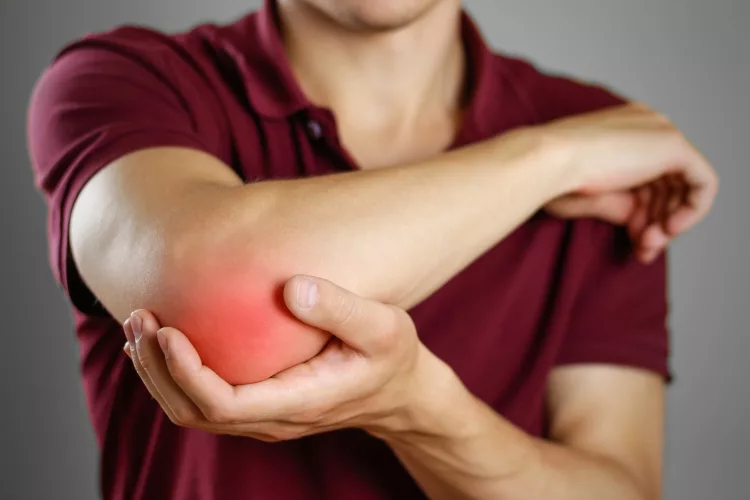
Purines, a kind of molecule found in human bodies as well as many foods, are broken down by enzymes in our systems, resulting in the production of uric acid. Some people have high levels of uric acid because their systems produce more than they require, or because they can't get rid of it quickly enough.
In certain individuals, uric acid builds up in the joint and forms syringe crystals, causing severe aches and pains in short bursts, a condition known as metabolic arthritis. Gout is one of the most frequent types of metabolic arthritis.
Gout is an inflammatory disease that does not cause widespread inflammation like rheumatoid arthritis or psoriatic arthritis. Gout primarily affects the toes, although it can also harm other bones. Gout can come and go in stages, or it might become chronic if uric acid levels aren't reduced, causing pain and disability.
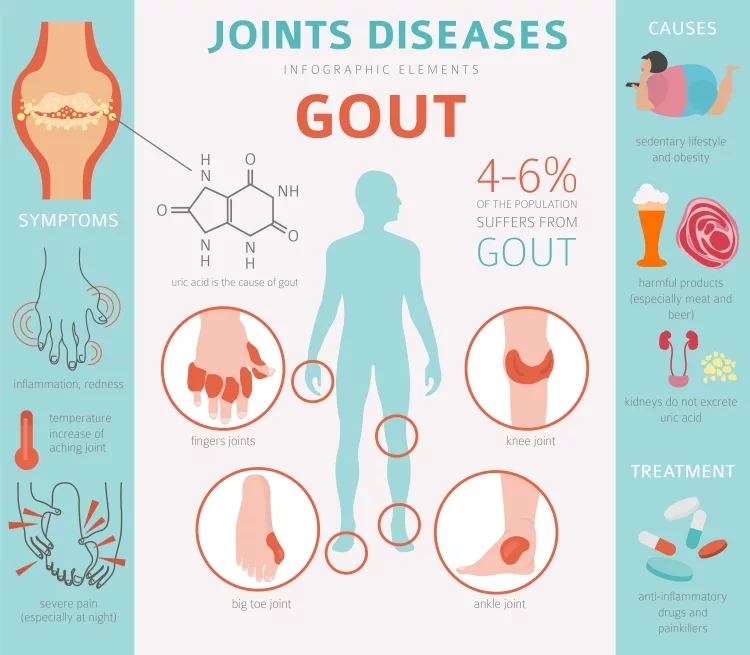
Gout is the most common form of inflammatory arthritis in males, affecting approximately three million people in the United States. Females, on the other hand, are more likely to develop gout after menopause, despite the fact that the illness affects them less in general. Gout attacks can hit without warning and can recur over time. This recurrence can cause oxidative stress in the inflamed area over time, which can be painfully painful. Hypertension, coronary artery disease, and obesity all contribute to gout.
Gout, which is a form of arthritis in and of itself, is divided into several categories. These classifications are based on how a gout episode usually progresses. The following points are explored in further depth:
A person's uric acid levels may be high without generating any symptoms. Although most people do not require treatment at this time, high levels of uric acid in the body can cause damage to blood vessels that are not apparent. As a result, a doctor may advise a patient with high uric acid levels to take steps to identify conditions that may be contributing to the acid's build-up.
Here is an informative video about how to get rid of excessive uric acid in your body to prevent gout attacks:
This stage occurs when urate crystals in a bone cause an inflammatory reaction and muscular spasms. A "flare" is a sudden attack that can last anywhere from three days to several months. Unpleasant life circumstances and excessive drinking might aggravate flare-ups.
This stage begins in the midst of a gout attack. When a person's gout worsens, these times get shorter. Between these periods, urea crystals may continue to develop in the mucosa.
Chronic tophaceous gout is the most painful type of gout, and it can damage bones and kidneys for the rest of one's life. During this phase, patients with chronic gout and tophi in cooler parts of the body, such as the bones of the hands, may develop tophi. Chronic tophaceous gout occurs after several years of acute gout attacks. On the other hand, those who receive proper treatment are unlikely to reach this level.
Pseudogout, or calcium pyridine phosphate deposition, is a condition that medical professionals commonly misunderstand as gout. The symptoms of pseudogout are quite similar to those of gout, however, the flare-ups are usually less severe. The fundamental difference between gout and pseudogout is that the joints are aggravated by calcium phosphatidyl crystals rather than urate crystals.
Certain diseases have no symptoms at all. For example, a person may have high cholesterol for decades without recognizing it, and many cancers may not manifest symptoms until they are advanced. These are known as asymptomatic diseases, and while signs are often linked to discomfort or poor function, a sickness without symptoms can be deadly. Several infections went undiagnosed for a long time. These are known as preclinical infections, and they can be contagious even if the infected person shows no symptoms. The sickness can still spread from person to person during the initial cycle, or when the virus gains possession of the individual.
For extended periods of time, some infections go undiagnosed. These diseases are known as preclinical infections, and they can be infectious even if the infected individual exhibits no symptoms. During the initial cycle, or when the virus takes control of an individual, the illness can still transmit from person to person.
This is why it is critical to understand the symptoms of the disease you believe you are experiencing in order to arrive at the most appropriate and reasonable conclusion. The following are some of the most typical signs and symptoms that suggest you have gout:
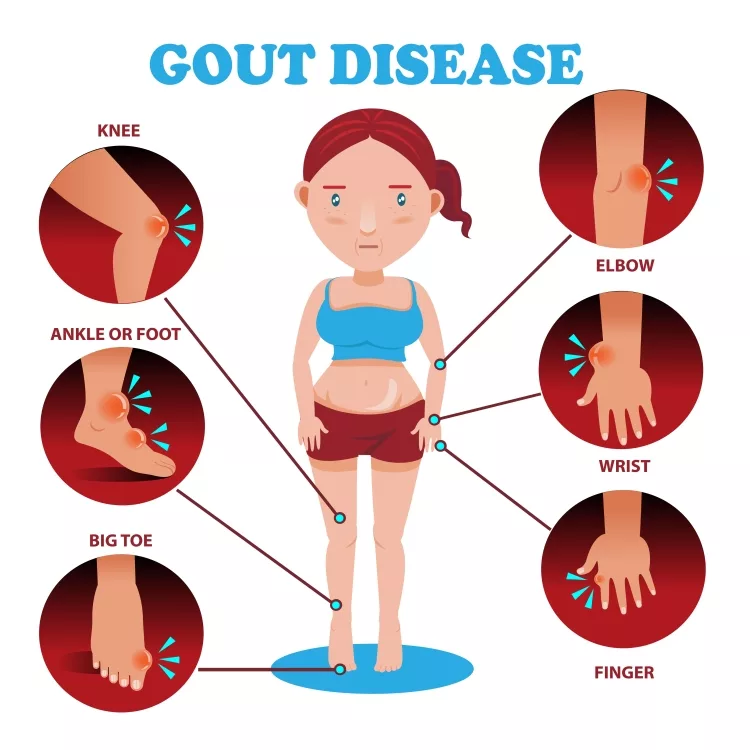
The big toe is the most common site of gout, but it can affect any bone. Other joints that are commonly affected include the limbs, elbows, shoulders, wrists, and fingers. During the first four to twelve hours after it begins, the soreness will most likely be the worst.
This video will help you with eating healthy to get rid of severe joint ache:
Residual joint discomfort in a gout patient can last anywhere from a few days to a few months after the most severe pain has passed. Future emergencies are more likely to last longer and affect more joints. The soreness will usually diminish as the injury heals. Chronic pain, on the other hand, is distinct from regular discomfort. If you have chronic pain, your body will continue to send electrical impulses to your consciousness even after an effective show in pain reduction. This might last anywhere from a few weeks and several seasons.
Clinical depression can reduce your flexibility, stamina, and fitness, as well as limit your range of motion. As a result, it may be difficult to do daily tasks.
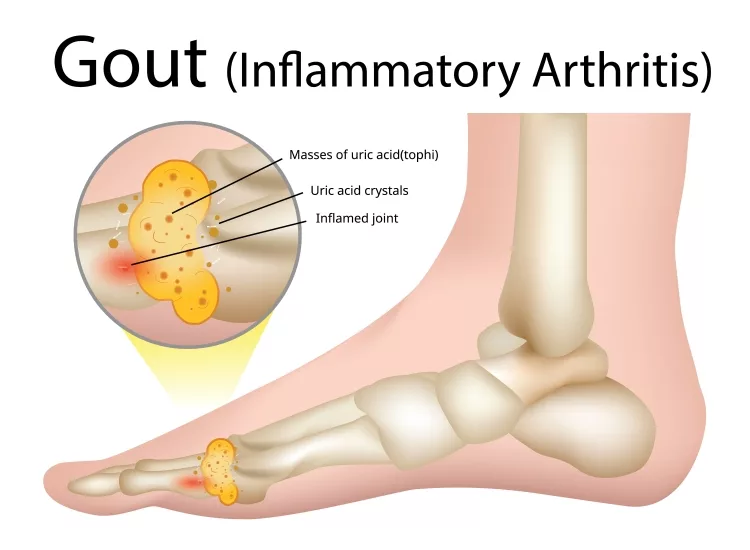
The most prevalent cause of pain, stiffness, and edema in inflammatory arthritis and gout is an inflammatory reaction of the synovial membrane. "Synovitis" is the medical term for this condition. It is critical to understand that not all joints are made equal. They are available in a range of forms and sizes, as well as the sorts of movement that they permit.
The typical range of motion from any of the joints is reduced due to a limited range of motion. The range of motion in joints decreases with age, but it can also be affected by a variety of illnesses, including gout.
A combination of one or more of these strategies can help prevent uric acid buildup, which triggers gout episodes. Medical professionals are encouraged to talk about the most effective and practical preventative measures. The following are some of the most important preventative measures you may take to avoid gout attacks:
Alcohol decreases the body's natural capacity to remove uric acid, increasing the risk of hyperuricemia and gout attacks. A gout attack can be caused by just one or two cans of beer, champagne, or liquor, and the risk multiplicity of drinks consumed increases with the number of cans consumed. Excessive or high consumption is defined as more than two drinks on any given day or more than seven drinks per week for males and females over the age of 65, and more than four drinks on any given day or more than 14 beverages per week for males 65 and younger.
Increasing your water intake can help your kidneys stay in shape and remove uric acid from your system. Depending on an independent test, weight, ethnicity, and other characteristics, the quantity of fluids that should be drunk each day varies. Drinking enough water to keep hydrated is essential for general health. Dehydration can cause slow thinking, mood changes, and overheating. Drinking enough water helps prevent dehydration, which can cause slow thinking, mood changes, overheating, diarrhea, and gallstones.
While further research is needed, there is some evidence that addressing sleep problems can reduce the frequency of gout attacks. As part of the treatment, a continuous positive airway pressure machine or another therapeutic equipment that improves oxygen flow during sleep is generally utilized. Increased oxygen consumption may lower uric acid production and the risk of gout episodes.
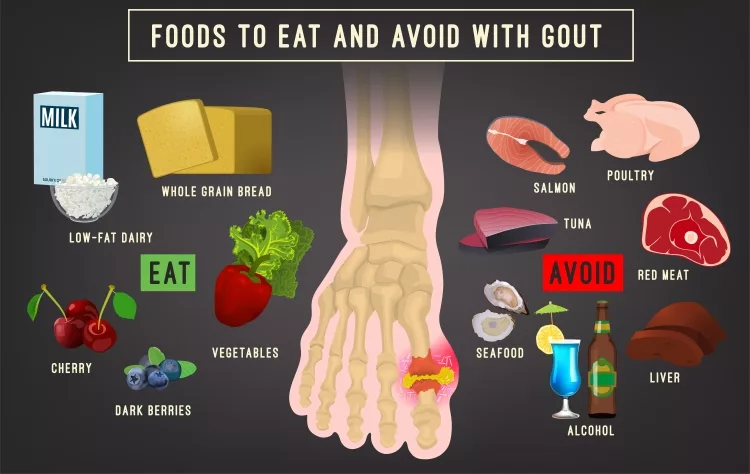
Gout can be prevented by maintaining a healthy weight through food and exercise. Rapid, substantial weight loss, such as that observed after surgical treatment, may increase the likelihood of a gout attack in the near future, according to research. Excess weight loss, whether quick or gradual, is an effective way to reduce risk in the long run.
Appropriate nutrition was evaluated and graded based on anticipated consumption of nutrients such vegetables, fruits, hazelnuts, whole grains, lean meats, and omega-3 fats, as well as hazardous items like animal-based meals, sugar-sweetened beverages, saturated fat, and salt. It is critical to include nutritious foods in your meals and to avoid eating harmful foods as much as possible.
This video will guide you to make a balanced diet platter for your meals:
We addressed arthritis and its many forms in this tutorial, with gout being the major topic. We took into account every conceivable element of detecting and avoiding gout. Don't forget to share this guide with your friends and family if you find it useful!
Thank you! Have a healthy life!
 |
 |
 |
 |
Great Ones for You